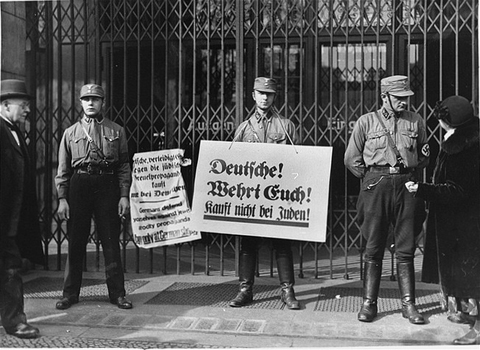The approximately 500 000 Jews living in Germany (almost 0.77% of the population) soon began to feel the force of Nazi anti-Semitism. The coming to power of Adolf Hitler (link in Czech) and the NSDAP saw the beginning of a process in which Jews were excluded from German society, bullied and persecuted. Although it was slowed down at times for reasons of tactics and international politics, the aim of this process was, from the very start, the destruction of Jews.
The period immediately following the Nazi seizure of power was marked by spontaneous
persecution, above all by SA units, who in various places conducted intimidation and terror campaigns, and physically attacked the Jewish population. The first Jews, in particular immigrants from Eastern Europe, were sent to concentration camps. From the earliest days of the new regime, various decrees relating to Jews started to be issued, limiting their ability to carry out their professions, enter public facilities and so on. Many of these decrees were issued by local authorities, and numerous German communities put up signs forbidding Jews from entering their territory.
One of the chief demands of all anti-Semitic programmes was that Jews should be squeezed out of the economy. On the 1st of April 1933, the Nazi regime announced a boycott of Jewish tradesmen, craftsmen, lawyers and doctors, accompanied by intensive anti-Semitic propaganda that claimed the boycott was merely reciprocation for the hostile attitude of foreign Jews towards the new German regime. Observance of the boycott was supervised and enforced by members of the SA and SS. On the 4th of April, the boycott officially ended, having been deemed to have fulfilled its aim. After the first revolutionary
phase of the persecution of Jews and their expulsion from the German economy, the Nazis, fearing economic loss, chose to pursue a more cautious approach, and exercised slightly more restraint in these spontaneous
measures against Jews. Still, the process of the economic and social ostracism of Jews never stopped; it was only speeded up or slowed down according to the circumstances.

SA members carrying out a boycott of Jewish shops. (Photo: National Archives, courtesy of USHMMPhoto Archives)
Immediately after the takeover, artists, scientists and other significant public figures of Jewish origin were pushed out of their functions. Many of them chose to emigrate, the best-known being the physicist Albert Einstein, creator of the theory of relativity, who emigrated to the US.
Systematic efforts of forcing Jews out of other professions also began. Many lawyers, doctors and university professors had to leave their jobs. On the 7th of April 1933, a law on the renewal of the civil service was passed (Gesetz dur Wiederherstellung des Berufsbeamtentums), which allowed non-Aryan
, Communist and other officials whom the Nazis considered untrustworthy to be made redundant. The removal of Jews from the civil service was without doubt the main aim of the law, and on its basis several thousand non-Aryan
employees were dismissed.
During the entire period after the Nazis took power, the German population was subjected to a long-lasting and unrelenting anti-Semitic campaign. The aim was to convince Germans that world Jewry was to blame for Germany's defeat in the First World War and its subsequent humiliation, and that only by ridding itself of Jews could Germany bloom again. Nazi propaganda also claimed that racial purity had to be maintained, and that the mixing of the allegedly superior German race with others, above all the Jewish race, had to be prevented. Since 1923 the German Gauleiter (regional leader) Julius Streicher had published a fiercely anti-Semitic magazine called Der Stürmer, in which brutal anti-Jewish propaganda was complemented by heavily pornographic elements. Anti-Semitism and racism became a normal part not just of public campaigns, but also of teachings in schools. An extreme example of anti-Semitic propaganda for young people was a textbook issued by Stürm called Giftpilz (
THE NUREMBERG LAWS
The Nuremberg Laws (link in Czech), issued on the 15th of September 1935 during the annual congress of the NSDAP in Nuremberg, became the legal basis for the expulsion of Jews from public life in Germany. The law on Reich Citizenship stipulated that only Aryan Germans or people of kindred blood could be Reich citizens, while Jews became second-rate state subjects. The Law for the Protection of German Blood and German Honour banned marriage and extramarital relations between Jews and Germans, the employment of German servants aged 45 and under in Jewish households and the display of German flags by Jews. The third law prevented Jews from displaying the Reich colours (flags).
From the very first anti-Jewish measures in 1933, the Nazi bureaucracy wrestled with the question of who was to be considered a Jew, and on the basis of what criteria. The definition of a Jew that was used in the decrees accompanying the Nuremberg Laws was therefore significant. Anyone with at least three Jewish grandparents was considered a full Jew. People with one or two Jewish grandparents were considered Jewish Mischlinge of the 1st or 2nd degree. Belonging to a particular category under the Nuremberg Laws later played a deciding role in who was included in transports to the concentration camps.
Despite the undemocratic nature of the Nazi regime and the issuing of the Nuremberg Laws, in 1936 Germany hosted both the Winter and Summer Olympics. The Nazis used the occasion as an opportunity to create propaganda for the regime. For tactical reasons, for the duration of the Olympic Games anti-Jewish slogans were removed from the places in which they were posted, and the sale of the fiercely anti-Semitic magazine Der Stürmer was banned..